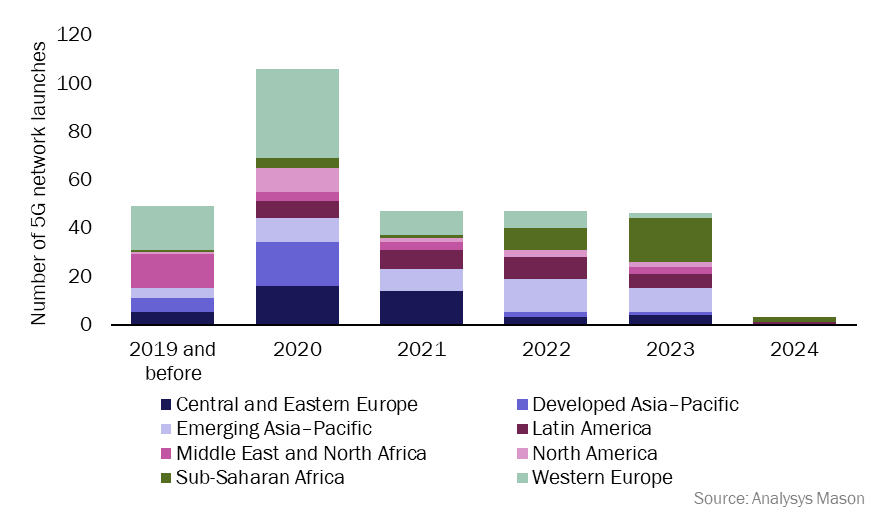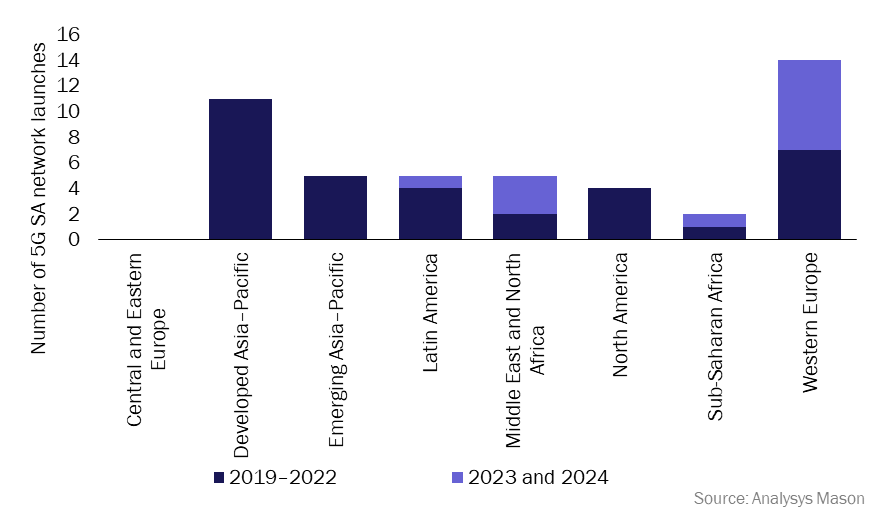Sub-Saharan Africa led 5G network launches in 2023, but 5G SA slowed despite growth in Western Europe
According to the latest edition of Analysys Mason’s 5G deployment tracker, 46 new 5G networks were launched in 32 countries in 2023, with an additional 3 deployments in early 2024.
Operators in Sub-Saharan Africa (SSA) led in terms of number of 5G networks launched in the second half of 2023. The region recorded a total of 18 launches in 13 countries in 2023, doubling the region’s launch figures of 2022. Emerging Asia–Pacific (EMAP) recorded the second most 5G launches in 2023, with 10 new launches in 7 countries. Additionally, there were 6 5G launches in Latin America (LATAM), 4 in Central and Eastern Europe (CEE), and 3 in the Middle East and North Africa (MENA). North America (NA) and Western Europe (WE) recorded only 2 5G launches each in 2023, and developed Asia–Pacific (DVAP) recorded only 1. The number of 5G standalone (SA) network launches slowed in 2023, with a total of 11 new commercial launches primarily in MENA and WE.
Our 5G deployment tracker includes 353 entries from 2018 to February 2024, with 298 confirmed launches of 5G networks and 46 commercial launches of 5G SA networks, worldwide.
Figure 1: 5G network launches, by geographical region, 2019 (and before)–2024

SSA’s 5G launches continued to surge in 2023, while EMAP now accounts for the second most operational 5G networks worldwide
As explored in Analysys Mason’s last 5G deployment article in August 2023, operators in SSA continue to launch 5G networks despite the region’s high number of users on legacy networks such as 2G and 3G (5G launches led by SSA). SSA accounted for a total of 39% of all 5G launches in 2023, and following two more launches in January 2024, has 35 operational 5G networks across 19 countries. This is more than LATAM (31), DVAP (27), MENA (24) and North America (18).
Notable 5G launches in SSA in 2023 and early 2024 include the following.
- Angola: Africell and Unitel both launched 5G networks in the 3–4GHz band in 2023. These are Angola’s first two 5G networks.
- Tanzania: Airtel launched its 5G network in August 2023, following Tigo Tanzania (Axian Telecom) in February 2023 and Vodacom in 2022. All three networks offer initial coverage in select areas of the country, including the capital Dar es Salaam.
- Somalia: Somalia recorded its first two 5G networks in early 2024, with Somtel International and Telesom both launching 5G services in January 2024. Both operators will implement a gradual roll-out across the country beginning with the capital, Hargeisa.
Although EMAP’s 5G launch figures decreased in 2023 compared to 2022, the region still recorded 10 new launches in 7 countries. EMAP now has 47 operational 5G networks, which is the second highest number worldwide, second only to WE (74). Notable launches in EMAP in 2023 include the following.
- Azerbaijan: Azerfon (Nar) and Bakcell both launched 5G networks in Azerbaijan in 2023. The country now has three 5G networks, following Azercell’s launch in December 2022.
- Georgia: Cellfie Mobile and SilkNet launched Georgia’s first 5G networks in December 2023 in Tbilisi and other select areas.
- Kazahkstan: Kcell (Activ) and Tele 2 became the first two operators to launch 5G networks in Kazakhstan. Initial coverage was provided in Almaty/Turkestan city.
- Uzbekistan: Uzbektelecom (Uzmobile) launched the country’s third 5G network in March 2023, following UMS (Mobiuz) in 2022 and Ucell in 2021.
The number of 5G SA launches worldwide slowed in 2023, but launch figures continue to grow in WE and MENA
Total 5G SA launch figures slowed in 2023, with 11 new deployments in 9 countries, down from the 15 5G SA launches recorded in 2022. Adoption of 5G SA has been slow largely due to operator concerns that the return on investment is unclear, the technology is immature and the migration from 5G to 5G SA is disruptive. In Analysys Mason’s 2023 operator survey, more than 50% of respondents chose technological immaturity as the main challenge facing their adoption of 5G SA. Economic challenges over the past year have also had a negative impact on operators’ willingness to invest, but Analysys Mason forecasts that adoption of the 5G SA core will regain momentum in 2024 and 2025. 5G SA core vendor revenue is expected to grow at a CAGR of 32.5% between 2023 and 2028.
The number of 5G SA launches in WE reached record levels in 2023. The region recorded the highest number of 5G SA launches of any region, with 7 new networks made live in Belgium, Denmark, Germany, Portugal, Spain (2 launches) and the UK. WE now accounts for 28% of all operational 5G SA networks worldwide, edging slightly ahead of DVAP (26%).
Figure 2: 5G SA network launches, worldwide, 2019–2024

There are now 46 operational 5G SA networks worldwide. Notable launches in 2023 and early 2024 include the following.
- Argentina: Telecom Personal launched Argentina’s first 5G SA network in December 2023. The operator has initially launched 5G SA services in Buenos Aires with 68 antennas operating in the 3.5GHz band. LATAM now has five operational 5G SA networks, with three in Brazil and one in Colombia.
- Denmark: TDC launched Denmark’s first 5G SA network in August 2023, using Ericsson’s dual-mode 5G core solution.
- Nigeria: Mafab Communications launched the first 5G SA network in Nigeria in January 2024, becoming only the second operator in SSA to do so following Multisource (Rain) in South Africa (2020). Mafab Communications has launched 5G standalone services in Lagos, Abuja, Port-Harcourt, Kano, Kaduna and Enugu.
- UAE: Du and E& both launched 5G SA networks in the UAE in 2023. E& initially launched 5G SA fixed-wireless access (FWA) services in May, followed by mobile services in October. Du launched 5G SA for FWA and mobile for compatible devices in December 2023. MENA also has operational 5G SA networks in Bahrain, Kuwait and Saudi Arabia.
Article (PDF)
DownloadAuthor


